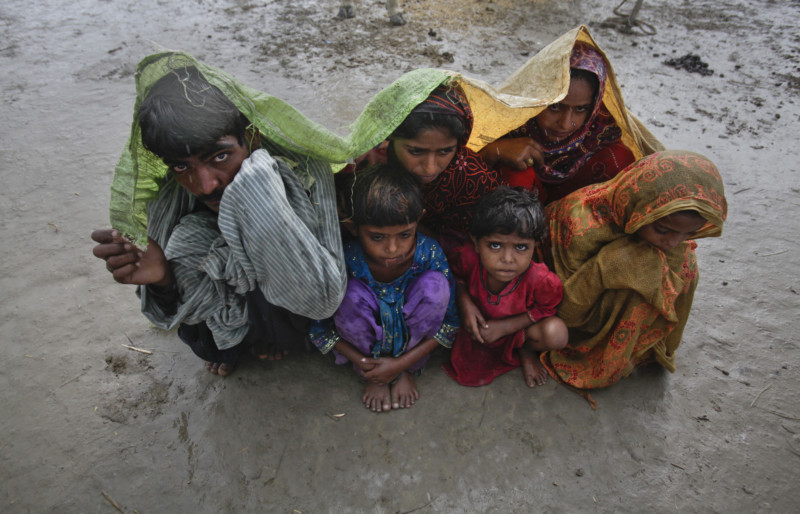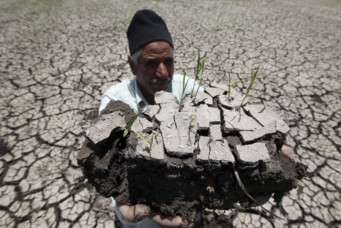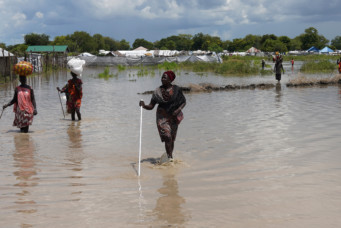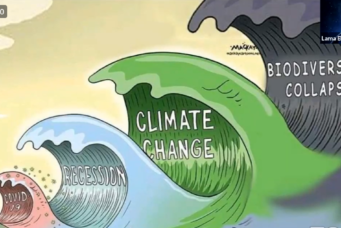Who Feels Climate Anxiety?
In the simplest terms, the answer is: it depends on who perceives it as a threat, and what “anxiety” means to them.

Family members, displaced by floods, use a tarp to escape a monsoon downpour while taking shelter at a make-shift camp for flood victims in the Badin district in Pakistan’s Sindh province, Sept. 14, 2011. Akhtar Soomro/Reuters
Many of my students have climate or eco-anxiety. It is a condition that results from the “chronic fear of environmental doom”, as the American Psychological Association defines it. Their climate anxiety is both an immediate experience of climate change’s effects in their own lives and a concern about their perceived unfolding of planetary demise. The threats are up-close and personal, and they’re distant and dispersed. The scale and intensity are overwhelming, especially when you start to learn that powerful stakeholders and decisionmakers are not doing enough to fix them. It was because of my students that I turned to studying the role of emotions in climate action. I even wrote a book on climate anxiety in 2020 titled A Field Guide to Climate Anxiety: How to Keep Your Cool on a Warming Planet. Since then, climate anxiety has only been on the rise.
Yet, a debate has emerged among climate emotion experts about whether climate anxiety is only for the privileged: those who may never have experienced other forms of existential threat, and who will be the last to feel the effects of climate change. The climate-anxious, according to this view, are worried about an unknown future, and so their dread is a testament to how isolated they have been thus far.
Climate journalist Mary Annaïse Heglar describes the privileged view as “existential exceptionalism”. According to Heglar, while the climate movement claims that climate change is the “greatest existential threat of our time”, it ignores the myriad historic and current threats to existence faced by more vulnerable communities. The “our” belies all the other struggles that have defined life for black and brown people, from slavery and colonialism to systemic racism and abuse. In this critique, frontline communities may worry about environmental problems, such as lead in the water or the siting of an incinerator, but the problems they worry about aren’t “the sixth extinction” or “the Anthropocene”: arguably more privileged framings of climate change.
Yet, in a stunning recent study that focused on climate anxiety among youth, climate anxiety is global phenomenon that cuts across categories of privilege, geography, and race. As that study suggests, youths from countries most impacted by climate change are the most likely to report feeling climate anxiety. Over 50 percent reported feeling sad, anxious, angry, powerless, helpless, and guilty, and over 45 percent said their feelings about climate change hindered their daily life and functioning. Similarly, in the United States, communities of color are more worried about climate change than their white counterparts. It makes sense that people experiencing climate change the most would feel the most anxiety about it. It also makes sense that youths around the world are feeling the most dread about how climate change will unfold, especially in their lifetimes.
The reality is that most of the world’s population has faced the prospect of an unlivable future. Climate-related traumas have been happening around the globe for a long time, and climate change compounds myriad other forms of insecurity. But this puts into question the very existence of climate anxiety as a phenomenon. In this logic, people worrying about starvation do not experience “climate anxiety” directly as much as they experience a suite of emotions that might better be defined as “trauma”. This is why climate change is often seen as a separate issue, and can even eclipse more local, pressing problems, which go by other names even if they are caused or exacerbated by climate change.
How can we reconcile this seeming contradiction: that some people on the frontlines of climate change feel climate anxiety, while others dismiss the concept as an affect of the privileged? Even those affected by climate change may perceive it as less of a threat. One answer is that culture and racial politics play an important role in shaping our anxieties toward the climate.
The Invisible Contours of Climate Anxiety
Climate anxiety often conjures a future problem. By its very definition, climate change cannot be perceived; the temporal scale for climate change does not match the scale of a person’s lifetime. Climate anxiety, then, is about a fear of some amorphous suffering that will manifest in some unknown future; the element of uncertainty is what makes it “anxiety”. Because “anxiety” is understood as having no explicit object of distress, it may not be the best word, then, for current experiences of climate change. Some theorists have tried to capture this element of futurity in climate emotions with new modifiers: “anticipatory grief”, “pre-traumatic stress syndrome”, or “global dread”.
Alternatively, experts have suggested other objects, such as “worry”. “Worry” has an object; it is visible to us; it has contours and is a physical manifestation, be it water in our living room, lead in our pipes, a fire raging through our town, a pandemic, or lung cancer. While all of these can be scientifically linked to climate change, they are easier to perceive as threats than climate change itself. Some people have also offered “climate distress” and “climate trauma” to capture the immediacy of frontline experiences and distinguish them from climate anxiety, which is then reserved for those whose present lives are fairly stable.
How the concept of time factors into these various climate emotions is one key to understanding the racial and cultural politics of climate emotions. Relatedly, temporality shapes risk perception. If something is an immediate threat, such as a pandemic, it is likely to be perceived as a greater threat than if it is a long-term problem. Indeed, climate change ticks almost none of the boxes risk perception experts say a threat needs to exhibit in order to be perceived at a degree proportional to the real scale of the threat. According to those experts, just because something is likely to be a threat doesn’t mean people will perceive it as such. And whether people perceive something to be a threat has little to do with the probability of it actually materializing. Climate change is a vapid enemy, which is why Greta Thunberg had to reframe it by urging us to respond to it “like your house is on fire”. It is difficult to narrate the threat of climate change in a way that gets people’s hair to stand on end. But of course, climate change will burn our houses down—it already is—and so why aren’t we mobilizing appropriately?
Cognitive dissonance—the sense of disconnect between knowing that your house is on fire but not acting like it—isn’t the only explanation. Environmental philosopher Timothy Morton’s theory that global warming is a “hyperobject”—something that is “massively distributed in time and space relative to humans”—helps explain climate change’s risk perception problem. Hyperobjects are “entities of such vast temporal and spatial dimensions … that makes them impossible to see as a whole”. Climate change fails to make us act like our house is on fire because it is such an elusive concept to grasp. It manifests like a whack-a-mole in so many interrelated but distinct phenomena across space and time.
In other words, our direct experiences of climate change will always be experiences of its proxies. In support of Morton’s point: hyperobjects are only detectable in the relationships they have among other things. So, climate change and anxiety can be spoken about in the concrete, immediate terms of “fire anxiety”, “hurricane distress”, “pandemic fatigue”, or “disaster mental health” and are clustered under an umbrella category of “environmental traumas” rather than “climate anxiety”. What is the value in recognizing that anxiety about any of these individual things is really anxiety about climate change? On the one hand, a unifying sentiment enables better coalition-building between different movements, but on the other, it erases nuance. Finding common ground between disparate problems is the way social movements and any kind of political organizing work, though, and so we should use it strategically.
Making Climate Change Perceptible to Humans
The rise of the idea of climate anxiety can be an opportunity for a multi-issue climate movement, even if it goes against the tendency to keep these arenas of concern separate. To make it less of a hyperobject, climate change must be linked to threats that can be perceived at a human scale and on human time. Experiences of climate change depend on where people live and their relative access to power; depending on that, they may not articulate their experiences of climate change as such.
Like the parable of the blind men all touching different parts of an elephant and each guessing incorrectly what the elephant is, it is possible that climate change will manifest in people’s lives in very different ways. For example, if it’s true that alleviating poverty will help mitigate climate change’s worst effects, people’s experiences of climate change may be that of worsening poverty, not melting ice caps. Someone in one place might be experiencing sea-level rise displacement, while the climate trauma in another place may be in the form of decreased access to traditional foodways. And a person with more resources may experience increased heat and extreme weather events; even Prince Charles is worried that his grandkids will experience thirty-six times more heat waves than he did in his lifetime. My students are fleeing wildfires. These are distinct experiences of climate change; the experience of time and factor of vulnerability afforded by wealth and race shapes how different people will experience climate change’s effects. But the affective tone is similar: fear, dread, anger, anxiety.
In another example of race, climate anxiety as a concept fails to resonate among communities of color, even those most impacted by climate change. This is in part because of these racial politics of risk perception. In the United States, race is the greatest factor determining one’s exposure to environmental risk. Climate change will only amplify this, just as the COVID-19 pandemic exposed how race shapes health disparities and access. Yet, for these communities, being abandoned by support systems and the government—the legacy of slavery, colonialism, and white supremacy—is the defining experience of systemic racism. The enemy here isn’t exactly climate change, and one emotion about these legacies may be anxiety, but it’s also a lot of other things—anger, determination, fear, or betrayal—better captured perhaps by the term “intergenerational trauma”.
In other words, what a person perceives as an existential threat depends on their relative vulnerability, their position within hierarchies of disposability, their sense of themselves and their community within an arc of history, as well as the stories they believe about their proximity to a threat. These are the contexts that risk perception experts analyze to figure out why people fear some things but not others.
Climate Anxiety Is Shaping Culture and Politics
But perhaps another way to approach the seeming paradox that those who experience climate change don’t always feel climate anxiety is that emotions are formed by culture; they are not pre-determined or universal. Affect theorist Sara Ahmed’s work, especially the Cultural Politics of Emotion, and neuroscientist Lisa Feldman Barrett’s research in How Emotions Are Made, show that people don’t feel emotions in a vacuum; their cultural backgrounds, conditionings, and life experiences shape the meaning they give to their experiences, which in turn determines how they feel about them. In other words, the stories they tell about what an experience means happens prior to having feelings about it. The story determines the feelings.
Put another way, how we make sense of our experience is determined by our context. Affect scholars have contextualized emotions like anger in this way: anger means different things to different people depending on cultural and family context, gender, race, and other conditions of power. Race theorists explicate the emotion of guilt similarly; guilt can act as an aversive emotion, prompting fragility and rarely activating change. Thus, discussion around any emotion, whether it’s distress or worry or anxiety, ought to consider different cultural contexts, identity, power, and language. Positionality, or one’s relative access to social and political power, shapes which emotions are permissible or likely. Emotions are situated.
Therefore, we should be nuanced in how we talk about climate emotions cross-culturally, even within our own neighborhoods, families, schools, and places of worship. Attentiveness to the way emotions are situated is necessary if we are to address both climate change and the mental health dimensions of climate change in all of these different spaces.
Thus, both “climate” and “anxiety” are relative; they mean different things to different people. Any feeling, from love to grief, cannot be assumed to be culturally universal. We can’t assume that these emotions mean the same things in different communities, that they are caused by the same things across communities, or that they will result in the same responses. A simple example of this is the phenomenon of wildfires in California. Cultural meanings of the fires vary immensely. To some, a fire conjures great fear, a sign of the climate apocalypse. To indigenous cultural burners and others, it is a solution to climate change, while the suppression of fire is both a cause and effect of colonialism, not just climate change.
Why does this matter for climate anxiety? Because while we may all be experiencing climate change—in all its myriad, dispersed manifestations—we may not all necessarily respond to these experiences in the same ways. It also matters because, if we are to mobilize resources to address climate anxiety—both in supporting mental health and in stemming climate change itself—it is imperative that we do so in a way that makes sense from the experience of others.
Seeing the Elephant and De-Privileging Climate Anxiety
The potential in organizing around climate justice will happen only after connecting the dots and in seeing the parts related to the whole (the hyperobject, or elephant). As we start to see all parts of the elephant as a whole, we can see that the problems different communities experience can be tied to climate change. Moreover, this view helps us see climate change as part of a larger system that touches people’s lives in so many ways: from biodiversity, access to resources, and subsistence to policing, health justice, and migration.
Furthermore, the assumption that only privileged people can care about global warming reinforces troubling assumptions and can result in a greater silencing of the voices of people most impacted. Climate anxiety can be felt by anybody who is cognizant of how their own wellbeing is tied to the wellbeing of the earth’s affected ecosystems. For example, many indigenous scholars argue that indigenous communities are in the best position to be thinking about futurity; they cast their net of ethical care far more widely than Western cultures do, thinking not just about the moral injury that environmental destruction does to species and people far away from the source of harm, but far away in time. This is why indigenous communities advocate for a “seven generations” ethical commitment—how will our actions now be realized in the lives of our posterity seven generations hence?
Moreover, to assume that people of color don’t care about the planet’s future pigeonholes them as unenlightened about the climate and incapable of the scale of care required in this moment; in many cases, they model traditions of care that the rest of us need to cultivate. It also justifies their exclusion from the table where conversations about the planet’s future with its so-called stakeholders are happening. Just because they aren’t suffering from climate anxiety as it is currently defined doesn’t mean they aren’t deeply attuned to what is happening to the world.
Just like my students, it is possible to feel climate anxiety even if climate change isn’t the first or worst existential threat of our lives. It is possible that people can feel immense care for the planet and its inhabitants, and not feel anxiety at all; anxiety isn’t a prerequisite for care or action. It is possible to have big feelings about other threats that may happen in relation to climate change without ever using the words “climate change”. Other feelings might arise in relation to addressing climate change: resilience, compassion, love, and the thing that happens when we experience a sense of purpose and meaning despite and amid our suffering: eudaimonia.
Tending to these cultural politics of climate anxiety is not about shaming privileged people for their legitimate distress about planetary health and their (perhaps new) awareness of their own vulnerability. Likewise, we shouldn’t shame people who don’t feel climate anxiety, for example, or assume that just because they’re not using the words “climate” or “anxiety” that they aren’t deeply worried about the viability of life on this planet.
The variety of experiences here is important to recognize if we are going to bring the full powers of emotional intelligence to climate work. But most importantly, we should approach the emotional landscape of climate change with a robust awareness of the cultural politics of emotion: how they shape power relations and change culture, and how culture and power mediate emotions. This is just as true for environmentally-related emotions like climate anxiety; it isn’t just a feeling people have that we need to learn to cope with. It also shapes culture and politics. Ignoring the cultural politics of climate anxiety renders us far less able to address climate change together.
Sarah Jaquette Ray is professor and chair of Environmental Studies at Humboldt State University in Arcata, California. She is author of The Ecological Other: Environmental Exclusion in American Culture and A Field Guide to Climate Anxiety: How to Keep Your Cool on a Warming Planet.
Read More



